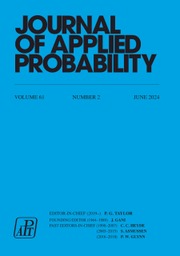Article contents
Stochastic ordering for birth–death processes with killing
Published online by Cambridge University Press: 16 September 2021
Abstract
We consider a birth–death process with killing where transitions from state i may go to either state  $i-1$ or state
$i-1$ or state  $i+1$ or an absorbing state (killing). Stochastic ordering results on the killing time are derived. In particular, if the killing rate in state i is monotone in i, then the distribution of the killing time with initial state i is stochastically monotone in i. This result is a consequence of the following one for a non-negative tri-diagonal matrix M: if the row sums of M are monotone, so are the row sums of
$i+1$ or an absorbing state (killing). Stochastic ordering results on the killing time are derived. In particular, if the killing rate in state i is monotone in i, then the distribution of the killing time with initial state i is stochastically monotone in i. This result is a consequence of the following one for a non-negative tri-diagonal matrix M: if the row sums of M are monotone, so are the row sums of  $M^n$ for all
$M^n$ for all  $n\ge 2$.
$n\ge 2$.
Information
- Type
- Original Article
- Information
- Copyright
- © The Author(s), 2021. Published by Cambridge University Press on behalf of Applied Probability Trust
References
- 1
- Cited by


